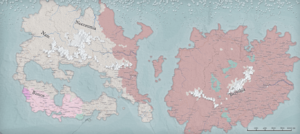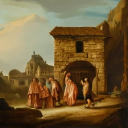Saletrism
This article is incomplete because it is pending further input from participants, or it is a work-in-progress by one author. Please comment on this article's talk page to share your input, comments and questions. Note: To contribute to this article, you may need to seek help from the author(s) of this page. |
| Saletrism | |
|---|---|
| Type | Universal religion |
| Classification | Niklausian |
| Scripture | Nilkaus' Laws of Holiness and Saletrism |
| Theology | Polytheistic |
| Region | Worldwide |
| Language | Niklausian Ledonian |
| Territory | Saletry World |
| Founder | St. Niklaus |
| Origin | 1523 BL Berushia, Ledonian Empire |
| Separated from | Voruchuism |
| Number of followers | 4.7 billion |
Saletrism is a Niklausian polytheistic religion centered on the teachings of Saint Niklaus and his mandate in Niklaus' Laws of Holiness and Saletrism. Its adherents, known as Saletrists, are estimated to be 4.7 billion people, comprising 48% of the global population, making it the largest religion in the world. Saletrists believe that the Gods are the creators of balance, and will one day reveal themselves as one, known as the Karlotta. Saletrists consider Niklaus to be the Nuntius, through whom the Gods gave the Holy Word, which is recorded in Niklaus' Laws of Holiness and Saletrism. Generally, the followers of Saletrism all hold Niklaus to have been burned, impaled, and chopped into pieces by Voruchists before being reborn via the Saletry River (or Holy River), after which he began teaching the Holy Word. The main religious festival is Niklaus' Holy Day, which celebrates the rebirth of the saint and the publishing of Niklaus' Laws of Holiness and Saletrism.
Saletrism originated in Ledonia in 1523 B.L., in the province of Berushia after the rebirth of Niklaus following his execution for disagreements with the bishops of Voruchism. Saletrists believe that the Gods gave him the Holy Word, and Niklaus spread his teachings across the province, leading to the eventual separation of Saletrism from Voruchism in 1497. The ten disciples of Niklaus continued to spread his teachings across Ledonia, after his death in 1308, despite attempted executions. Saletrism emphasizes that the Gods are the only ones with ultimate control, and everyone will be judged by St. Niklaus upon their death; the righteous will be rewarded with eternal happiness (The Beatitudo Aeterna) while the unholy will be punished with eternal suffering (The Void).
Etymology
The term Saletry derives from the Old Ledonian word Saletrismusia, which is derived from the Ancient Greek Η μουσική του Σάλτερ, which means Salter's Music, which refers to the fact that Niklaus used to be a peasant who extracted salt, as well as how Niklaus' Laws of Holiness and Saletrism contains various songs of praise. The first recorded usage of the term was in 1251 B.L., by Priestess Demetra Priscus.
The historical name for the religion used to be Pauperum fides, an Old Ledonian phrase derived from the Greek word Η πίστη των φτωχών, which literally means "the faith of the poor." This name was coined by the Voruchuists as a derogatory term, as most followers of Saletrism were poor at the time.
History
Early Saletrism
Exile and execution of St. Niklaus
According to Niklaus' Laws of Holiness and Saletrism, St. Niklaus was born in the province of Berushia in 1569 B.L. and was abandoned early on in life. After floating down the Holy River in a basket, he was adopted by Æsop and Claudia IV and was taught the ways of Voruchuism. When he came of age, he began extracting salt from the present-day Berushiatic Salt Mines. In 1538, troubled by the alleged ignorance and xenophobia of High Priest Basillius III, retreated to a mountain cliff and isolated himself from the rest of the populace. This event is known as The Holy Retreat.
It was during his time on the mountainside that it is said that the Gods spoke to him for the first time. At first, the future prophet dismissed it as a hallucination, but only a month later, a thunderstorm rolled through that sent trees flying and "made the house shudder." Due to the near impossibility of such an event, Niklaus started going down to ground level, only to be confronted by a second, much stronger storm that "flipped boulders" and "nearly toppled me over."
Taking this as a sign, Niklaus returned to his small abode and prepared an animal for a sacrifice. After he burned the animal, the Gods supposedly spoke to him once more, commanding him to "preach the Holy Word of your Gods." For the next 11 years, Niklaus taught about the Gods, first to close family members, and then to large groups of people. In 1525, he was exiled for preaching alleged heresy; the Voruchuists felt that Niklaus' teachings about polytheism were destabilizing the worship of their own God.
In 1523, High Priest Basillius IV ordered for Niklaus to be executed. Niklaus was given the opportunity to say goodbye to his friends and family before the execution. His body was first burned in a casket for an hour. He was later impaled, before being chopped and having his remains scattered in a nearby river. He died at the tender age of 45.
Holy rebirth of St. Niklaus
After three months, the remains of Niklaus coalesced on the left side of the riverbed and reformed; the prophet was reborn, memory fresh and restored. He went on to preach the law across the country, using divine examples to assist in conversion. Many early converts were the poor, as many saw the alleged heresy as "something of the poor." Despite this, the Saletrists started calling the prophet St. Niklaus.
Soon, Saletrism, or Pauperum fidia at the time, had spread across the country. Several priests broke away from Saletrism during this period, only to be imprisoned. Meanwhile, St. Niklaus continued to preach about the Gods; he authored Niklaus' Laws of Holiness and Saletrism, the scripture of the religion.
Continued spread
By the time of St. Niklaus' second death in 1308, the religion had expanded to several corners of Ledonia. Ten disciples were chosen by the priests to continue to spread Saletrism across the globe. By 1208, adherents to the religion had increased by around 61%, a huge increase from a century before.
From 1200 B.L., Saletrist authors began producing theological works that were aimed at strengthening the position of Saletrism as the alleged true faith. These early authors were known as the Defenders of the Faith, and the study of them is referred to as Studium Defensorum Fidei, which literally means "study of the Defenders of the Faith." Notable Defenders include Minerva of Berushia, Cyrillys of Nocorumia, Longinus of Hetteroccinus, and Porphryasus of Neu Berushia. These authors also contributed to Niklaus' Laws of Holiness and Saletrism.
Persecution of Saletrists occurred on a small scale by anti-Saletrists, starting in 1135. Examples of early executions include the hanging of Cyrillys of Nocorumia, the burning of St. Athena, and the impalement of Priestess Oenone. Despite this, the religion continued to gain influence, tripling from its population in 1208 by 1092.
Unacceptance and persecution
By 1085, Saletrism had spread to the Ledonian-speaking people of Verdelain, as well as several Verdelainiatic-speakers along the west coast; it also had spread beyond Verdelain into the Camaganca and Θρησκευόμενο έθνος Empires. All three nations were strong in their beliefs in Voruchuism, and did not accept the spread of Saletrism. The Empires began sanctioning the execution of practitioners of the religion, as well as establishing stronger military presences to prevent Saletrist priests from spreading their "propaganda" across the globe.
Emperor Radamanthos VI of Θρησκευόμενο έθνος proclaimed Saletrism to be an enemy of the state, an "evil that must wither and perish," in the late 11th century BL, making Θρησκευόμενο έθνος the first state to officially denounce Saletrism.
Radamanthos VIII was heavily exposed to the religion in his youth, and throughout his lifetime his hatred for the religion grew, eventually ending in a wish for it to be exterminated. Subsequently, his great-nephew Radamanthos IX succeeded to the throne, and bribed Longinus of Hetteroccinus into betraying his faith and turning in his former fellow Defenders of the Faith to the new Emperor. Once Longinus turned in his last companion, he too was executed.
During the reign of Radamanthos, it became illegal to be identified as Saletrist in Θρησκευόμενο έθνος, following the Holy Proclamation of 896. This inspired Verdelain and Camaganca to also illegalize the religion. By this point, Saletrism had became a minority religion, only accounting for 8% of the population; the continued oppression from the Voruchuists in Θρησκευόμενο έθνος, Verdelain, and Camaganca encouraged practitioners of Voruchism within the birthplace of Saletrism to do the same in Ledonia.
Holy Wars
In 739, the province of Berushia peacefully broke away from Ledonia, and became the first state to mandate Saletrism. Given the size of the new nation, this caused Saletrist numbers to more than double in the next decade. Despite this, opposition to the religion increased, leading to an eventual religious war that shook both religions drastically.
The first battle in the war, taking place in the Ol' City of Vrebsicourg, resulted in a victory for the Saletrists, as the city had grown to be a bastion of sorts. Throughout the next 300 years, the war continued to escalate, with the opposing sides burning holy libraries and stoning priests. The war eventually ended in 429, with Voruchuism agreeing to stop persecuting Saletrists.


